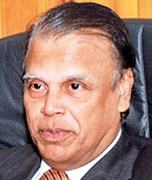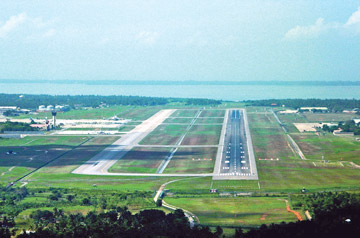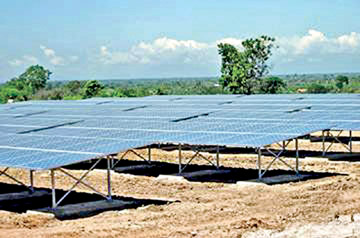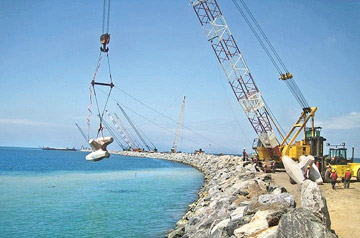|
[Development]
Goal of development projects:
Reaching self-sufficiency in every sector
By Shirajiv SIRIMANE
|

Galle Port
|
Sri Lanka's ancient kings left behind one of the world's best
irrigations systems to the country and the colonial rulers built a rail
and road network and harbours, mainly focusing on the benefits they will
gain.
After Independence, the then Prime Minister D.S. Senanayake
redeveloped the irrigation system including the Gal Oya project while a
few power generation projects too were carried out from time to time.
Subsequently, the Walawe Ganga Scheme (1965) saw the construction of
three major reservoirs, the Uda Walawe rainwater reservoir (3,415 ha),
Chandrika Wewa (448 ha) and Ridiyagama Reservoir (888 ha). It also
involved restoration and construction of minor irrigation reservoirs,
anicuts and channels.
The Mahaweli project, Gam Uda housing schemes, export processing
economic zones and garment factories, the new Parliament and the BMICH
were some of the other key projects carried out since Independence
though the country did not see any significant improvement in the rail
sector.
It was during the late 1950s that the legend of Singapore, Lee Kwan
Yu said that they want to emulate Sri Lanka as its role model. Singapore
did just that, while Sri Lanka lagged behind and today people are
talking about Sri Lanka following in Singapore's footsteps.
|

Dr Sena Yaddehige |
It was not just the conflict that left a huge gap between Sri Lanka
and Singapore, but it was also the lack of leadership. One has to agree
that the Sinhala Only bill implemented during the 1950s was a major
setback to the country and IT experts say that had this not being
implemented, the Silicon Valley in Bangalore would have been created in
Sri Lanka. This was a golden opportunity that the country missed.
Economists say that the closed economy in the 1970s, which had its
pluses and minuses, was another aspect that people want to forget along
with the LTTE terror period.
The solution

Southern Expressway |

Lakvijaya power project |

Mattala airport site |

Work under way at Upper Kotmale |

Solar power project at Hambantota |

Colombo Port expansion project |
Leadership had always been a gray area for Sri Lanka as she did not
have leaders of the calibre of Lee Kwan Yu, Mahathir Mohamed and the
rulers of China, Korea or Japan who made their countries super powers.
For President Mahinda Rajapaksa it was a challenge to develop the
country, as it was 20 years behind where it should have been. To give
the country its due place, a long-term plan was needed and the Mahinda
Chinthana was the solution as it identified key areas that needed a
boost. Five years after the implantation of the Mahinda Chinthana, aimed
at making Sri Lanka the Wonder of Asia, the country is on track to
achieve its goals.
One of the top entrepreneurs of Asia, Arpico Chairman Dr. Sena
Yaddehige said that Sri Lankans can be proud of the country's road
network which he said was of a high standard.
Sri Lankans can also be proud of the Southern Expressway and also the
massive road development that is taking place all over Sri Lanka
including the North and the East. "Did you ever dream that Sri Lanka
could have a highway of this nature?", he asked. The Government would
invest an additional Rs. 1.1 billion to develop the road network.
Quick road connectivity between cities would also help investors to
move out of Colombo, thus helping to breach regional disparity.
He said that building additional international airports and harbours
was a step in the right direction and the country needs them for the
future. "This was a right investment made at the right time by the
Government," he said.
He said the Hambantota harbour and Mattala airport would play a key
role in the country's future economy and more such Government-funded
investments are needed.
Sustainable energy
Today Sri Lankans are assured of uninterrupted power and the promise
is that the entire country would be wired by next year. The Power and
Energy Ministry announced that Sri Lanka's new hydro power electricity
project at Upper Kotmale will add 150 megawatts to the national grid.
The Japan-Sri Lanka combined project will be commissioned on March 27 by
President Mahinda Rajapaksa."The increase in the electricity capacity
will help the Ceylon Electricity Board (CEB) to reduce the electricity
levy and provide an uninterrupted power supply to 4.3 million
electricity consumers," he said.
Eco-friendly, sustainable renewable energy such as solar power is the
way forward. When Sri Lanka faced a looming energy crisis, a solar power
plant was commissioned in Hambantota to meet the electricity needs of
the area. The new plant, which will add 500 kw to the national grid, has
been touted by authorities as the first such solar power plant in Sri
Lanka. The plant will generate 2,300 units of electricity daily, and is
expected to generate 839,500 kilowatt hours of power annually.
The agreement for the setting up of a 500 MW coal-fired power plant
at Sampur, Trincomalee, a joint venture between the Indian State-owned
NTPC Ltd and CEB was also inked. The country's first coal power plant,
the Lakvijaya Power Plant, of which the construction was abandoned for
many years, was also commissioned. The first stage of the plant will add
300 megawatts of power to the national grid. Upon completion of the
second and third stages of this plant, the project will add 900
megawatts of power to the national grid.
The power plant at Norochcholai under Phase One will generate 300 MW,
which will amount to 17 percent of the national power requirement.
Electricity supply projects
Arrangements have been made to implement 513 electricity supply
projects and a further 1,071 projects relating to the extension of power
lines. While tourism development is spearheaded by the private sector,
the Government is developing the infrastructure, increasing the air
passenger handling capacity to 12 million by 2015 from the current
capacity of six million. Sri Lanka aiming for a golden double of one
million tourists and one million US dollars in revenue from tourism, and
the country targeting nearly two billion US dollars in foreign direct
investments, are concepts which had never been in the radar for the past
40 years.
Sri Lanka will cater to South Asia's needs in handling larger vessels
with the construction of the Colombo Port's third container terminal
which is scheduled to be completed by 2016.
The Port of Galle would be developed as a tourist destination with
facilities for mooring of yachts in the marinas. Passenger terminals and
other facilities such as immigration, Customs and shopping centres will
be made available in this recreation port. In addition to Hambantota,
Trincomalee, Oluvil and Kankesanthurai harbours would be built to
international standards.
This is the first time in the post-Independence era that five
international harbours are being built while a second international
airport is being commissioned.
The construction of irrigation projects such as Moragaha Kanda, Upper
Kotmale and Uma Oya, costing billions of rupees, and building of
harbours would also help the agricultural and fisheries sectors, helping
them to achieve self sufficiency.
Minister of Economic Development, Basil Rajapaksa said that country
annually spends millions of rupees to import fish when the country is an
island and self-sufficiency in this industry is on the cards. He also
said that the Divi Neguma program would take the country towards
self-sufficiency in the fruit and vegetables sector.
CEO Mobitel Lalith Silva is of the opinion that Sri Lanka should not
try to emulate Dubai, Malaysia or Singapore.
"Sri Lanka can definitely aim to be among the top five nations in the
world in a few years as it has the leadership, resources and vision to
be there." |

